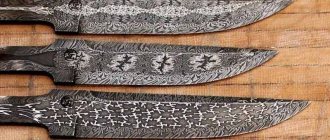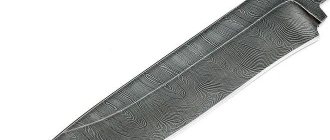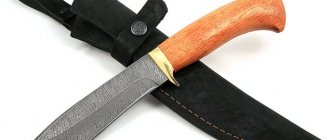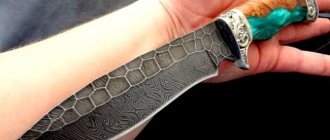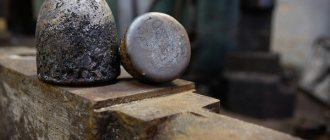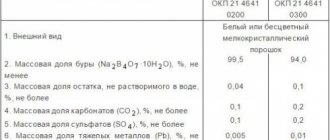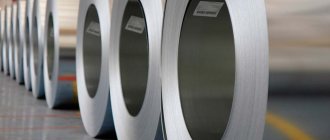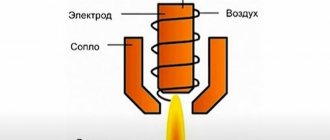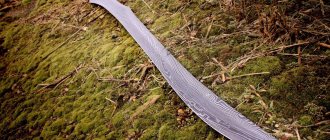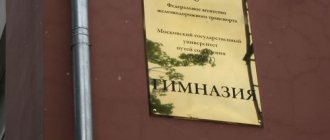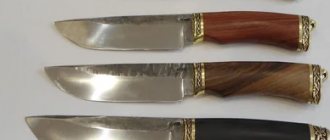What is damask steel and what is Damascus: differences between steels
To bring non-specialists up to speed, let's look at these two types of patterned steels separately. So:
Damascus
The translation of the word "Damascus" from Arabic sounds like water. This is due to the fact that blades made of high-quality Damascus resemble the surface of rippling water. This explanation is one of several options for the origin of the name of this metal. In essence, it is a package of steels of various grades, repeatedly forged by forging. The number of layers of modern Damascus can reach 150, 300, 600 or more.
Bulat
The smelting of modern damask steel is carried out by many workshops, and the result of their work is often difficult to attribute to damask steel. This article deals only with damask steel produced in the workshop of Sergei Baranov. The technology for producing this metal is based on archival workbooks of the great Russian metallurgist Pavel Petrovich Anosov. It was he who, in the 30s of the 19th century, received the first Russian damask steel, which was in no way inferior to the legendary patterned metal of antiquity.
Sergei Baranov's cast damask steel is obtained as a result of crucible remelting of a charge consisting of a mixture of special additives and steel grades: EI-107 and Kh12MF. Complex technology of long-term melting, special cooling and heat treatment methods make it possible to give the blades high hardness.
| Damask steel knife | Damascus steel knife |
Advantages and disadvantages
The special properties of Damascus steel, a kind of saw along the edge of the cutting edge, are a consequence of the presence of soft and hard grades of steel in the package. Depending on the original composition of the package, Damascus can be corroded or weather-resistant. Typically their Damascus blades have a hardness of 57-59 HRC.
The special properties of damask steel are high hardness combined with viscosity and strength. A damask knife with a hardness of 62-64 HRC has a strong cutting edge that is not prone to chipping. In addition, Baranov’s damask steel is not subject to corrosion.
Types of cast damask steel: high-carbon and stainless alloys
One more important note about damask and damask that is worth making right now. In their chemical composition, they most closely resemble the high-carbon steels we are used to, but with a very heterogeneous composition, and this means both increased strength and toughness, and susceptibility to rust. Carbon and stainless steel, as we know, are not just two steels with different compositions. The difference is rather vague - the whole point is whether the material contains alloying elements that increase the corrosion resistance of steel, and in what quantities.
So, normally damask steel corresponds to what we call carbon steel, but a modified chemical composition (adding a significant amount of chromium - from 14% or more) while maintaining the physical structure gives us the so-called stainless damask steel. It retains the properties of strength and hardness inherent in ordinary cast damask steel, and products made from it are almost as easy to sharpen. But a product made from it, like any hand-forged product, is incredibly expensive.
On the left is ordinary cast damask steel with a high carbon content; on the right - a stainless steel composition with conventional damask steel casting technology
Bulat
Damask steel blades are produced by casting. The technology involves the use of two types of steel: high- and low-carbon. Low carbon steel melts at a lower temperature. As a result, partially molten high-carbon particles will be present in the liquid low-carbon steel. This is how a characteristic damask pattern is obtained on the surface of the blades. The pattern on the blade of each knife is unique, like human fingerprints.
Damask steel itself is soft, but its surface is protected by carbon, which gives the finished product extraordinary strength with amazing elasticity. Damask knives retain their cutting properties for a long time.
Bulat, if it is not made from alloy steel, is susceptible to corrosion.
Damascus
Damascus steel and damask steel differ in that Damascus is produced by forging, and damask steel is cast.
The technology for producing Damascus steel is as follows: rods made of different types of steel are twisted in a special way, then the twist is forged many times. Here it is important to choose the right types of metal and maintain proportions, because There should be more hard steel than soft steel. Some craftsmen use 3 types of metal.
A similar mixture also forms a specific “layered” pattern on the surface of the finished blade. There is a rule regarding Damascus steel: the less noticeable the pattern, the denser it is, the better the working qualities of the knife, the more valuable it is. The ideal Damascus folding knife will have an almost uniform blade, without patterned tints.
There are special stainless steel types of Damascus steel. In any case, such a knife should not be left exposed to moisture for a long time.
The legend about self-sharpening Damascus is not entirely true: over time, the soft part of the blade wears off and a micro-file is formed, i.e. A Damascus knife needs sharpening, you just need to do it less often.
Bulat or Damascus
Bulat and Damascus steel, the difference is described above. The first type of steel is more highly valued by collectors. For hunting, you can buy a hunting knife made of either damask steel or Damascus steel. Professional hunters, when choosing the type of steel, focus more on personal preferences.
Source
Rules of use and care
- Since such a knife can rust, after use the steel must be cleaned, rinsed with water and wiped dry with a rag.
- Such metal products are stored in a warm, dry place, excluding the formation of condensation.
- It is better to use a leather case. For long-term storage, it is better to cover the blade with a layer of fish oil and paraffin.
- When rust appears, you need to immediately remove the deposits - kerosene is used, but aggressive agents are prohibited. You can also use fine sandpaper, but after processing you will have to etch the knife, since the design will fade.
What to look for when choosing
To remain completely satisfied with the purchase of a damask steel knife, you need to pay attention to:
- A chaotic drawing on a dark background - lines and dots should be clear and large, but not symmetrical. Smooth and symmetrical lines are a characteristic of cheaper Damascus steel.
- The ringing of monolithic damask steel is clear and long. If the blade is not solid (layers, fluctuations of various types), the sound will be low and short.
- A responsible manufacturer always indicates the purpose of the blade - the dimensions and parameters must match. The hunting blade is longer, the fishing and tourist blade is shorter, with a folding design.
- The assembly must be of high quality without gaps, burrs, etc.
- Documentation - warranty card, certificate (confirmation that this knife is a non-bladed weapon).
- Case/case.
Sharpening features
Damask steel is extremely strong, so sharpening it at home is not easy. It's better to entrust it to a pro. Such blades are sharpened with diamond stones, or a hard stone can be used.
As for the sharpening angle, you should stick to 30-45 degrees, the thickness of the edge should not exceed 0.5-1 mm.
Sharpening a damask knife.
Understanding the terminology
In general, everything here is not as difficult as it might seem. What these materials have in common is the presence of a pattern, but their manufacturing technologies differ radically. The legendary Indian damask steel is, unfortunately, a lost technology: it was once passed down orally and was so carefully hidden that it was completely lost several centuries ago. The production of damask steel was not cheap, and already in the 17th century, affordable and sufficiently high-quality industrial steel began to appear, so the demand for damask steel fell and then completely disappeared. Everything we know about it (partly thanks to history, partly thanks to the experiments of the Russian metallurgist Pavel Petrovich Anosov) fits into a couple of phrases - damask steel was exceptionally strong, sharp and, of course, legendaryly beautiful. In Rus', damask steel was often called kharalug (horolug), or kharaluzhnaya (horoluzhnaya) * steel, although in fairy tales we often encounter the term “damask steel” itself.
* You can find one or the other spelling. Perhaps the option taken out of brackets would be more correct, since, firstly, it is precisely this one that is found in ancient sources, in the same “Tale of Igor’s Campaign”, and secondly, it preserves the letter “a” in the common Turkic root “hara” /“kara” (“black”).
By the way, about fairy tales and epics. They attribute almost magical properties to damask blades, but it is wrong to think that this is some kind of non-existent, fairy-tale metal. In fact, damask steel was simply the best option for its time. Practical tests of even the best samples that have survived to this day show properties close to ordinary inexpensive carbon steels of modern manufacture. However, in the Middle Ages, the bulk of blades were made from such low-quality raw materials that even such properties seemed mystical and magical to contemporaries.
At one time, Anosov, in the first half of the 19th century, managed to create an alloy that fully met all the characteristics of damask steel. Although, of course, we cannot know for sure how similar the technology and composition discovered by our metallurgist are to the “original”. The fact is that there were several technologies for producing damask steel even in ancient times: it is not known for certain whether Anosov recreated one of them or came up with his own.
The damask steel blade of the Turkish saber is what we call historical damask steel
And now we come to the actual clarification. Historically, there were two main technologies for producing patterned steel. One of them involved casting, the other involved welding and forging several types of steels together; the first retained the name damask steel, and the second began to be called damask.
- Cast damask steel is patterned steel in the historical sense we are familiar with, produced by casting and forging methods.
- Welded damask steel (or Damascus) is patterned steel produced primarily by forging methods.
High-quality weapons were made from special “damask steel” ingots called wootz. It was the beauty of the damask pattern that was associated with its magnificent properties. But wootz was expensive and difficult to produce, which spurred the search for technologies for creating patterned blades by alternative means. What is now called Damascus began to be produced specially, by folding and forging several layers of blanks from different types of steel. The new material was not inferior in strength to damask steel, and in appearance it turned out to be much more beautiful than cast damask steel.
Now, a little more about the types of damask steel and types of damascus - we will make this division because we classify materials according to different principles: regarding damask steel, we will talk about the alloying elements in its composition, and regarding damascus, we will also talk about several technologies.
